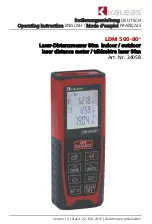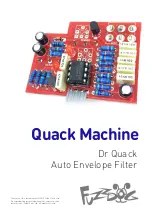
UNAOHM
EP2500 (Rev. 0)
35
•
Confirm by pressing
ENTER
.
•
the remaining programs will be displayed by means of
UP
or
DOWN
before moving
onto the next acquisition.
•
Press
BACK
or
ENTER
to return to MENU.
5.
To cancel the data related to the indicated acquisition position to CLEAR by means of
UP
or
DOWN
. Press
ENTER
,
CLEAR
(or
BACK
in order not to cancel).
6.
Press
BACK
to exit.
7.
Press
EXIT
to exit completely the Data Logger function.
7.20.4
Cancellation of All Data Stored
1.
Enter the Data Logger function pressing
DATA
(19)
.
2.
UP
or
DOWN
. Position to CLEAR ALL and press
ENTER
.
3.
CLEAR
to cancel the data,
BACK
to leave them as they are.
4.
Press
EXIT
to exit completely the Data Logger function.
7.20.5
Cancellation of the Last Datum Stored
1.
Enter the Data Logger function pressing
DATA
(19)
.
2.
UP
or
DOWN
. Position to CLEAR LAST ONE and press
ENTER
.
3.
CLEAR
to cancel the data,
BACK
to leave them as they are.
4.
Press
EXIT
to exit completely the Data Logger function.
7.20.6
Data Download
1.
Enter the Data Logger function pressing
DATA
(19)
.
2.
UP
or
DOWN
. Position to LOGGED DATA and press
ENTER
.
3.
UP
or
DOWN
. Position to DATA OUT and press
ENTER
.
4.
Press
EXIT
to exit completely the Data Logger function.
Or, as a more direct alternative:
1.
Enter the Data Logger function pressing
DATA
(19)
.
2.
UP
or
DOWN
. Position to DOWNLOAD and press
ENTER
.
3.
Press
EXIT
to exit completely the Data Logger function.
7.20.6.1
RS232 Transmission Parameters
The instrument leaves the factory with the RS 232 serial port configuration set as follows: Baud Rate
19200, Number of bits 8, Stop bit 2, no parity. The format may be changed as follows:
1.
Press
DATA (19)
.
2.
By means of
UP
or
DOWN
select DEVICE, press
ENTER
.
3.
By means of
UP
or
DOWN
select the parameter to be programmed among BAUD RATE, BIT
FORMAT or PARITY, press
ENTER
.
4.
By means of
UP
or
DOWN
select a value among those available for the selected parameter of the
menu, then confirm by means of
BACK
.
5.
Exit by means of
BACK
, then
EXIT
.
7.21
USE OF THE SCART SOCKET
The SCART socket -see Figure 17- is mainly used as:
1.
An output for an external colour monitor or one whose screen is larger than that of the instrument.
















































